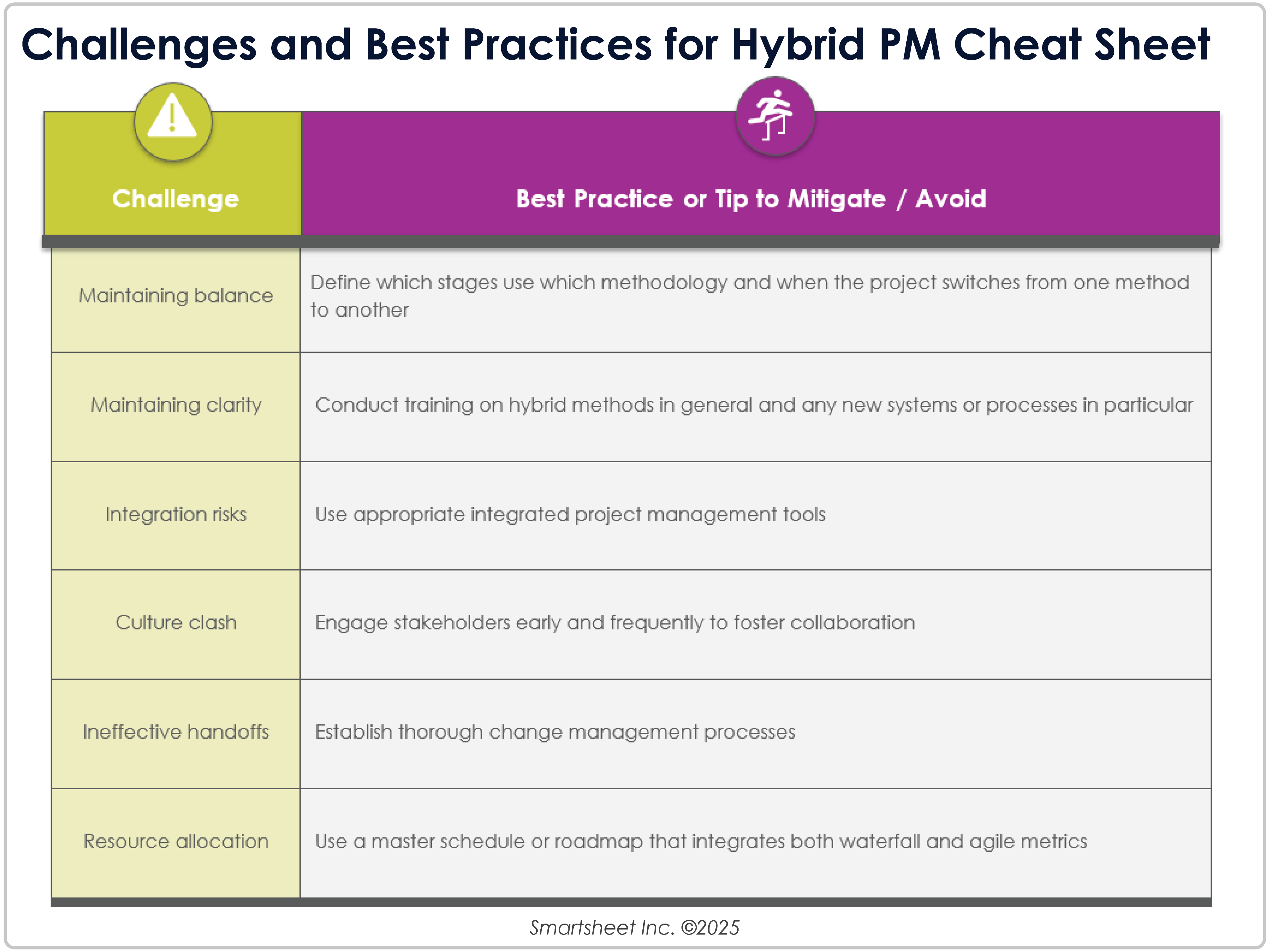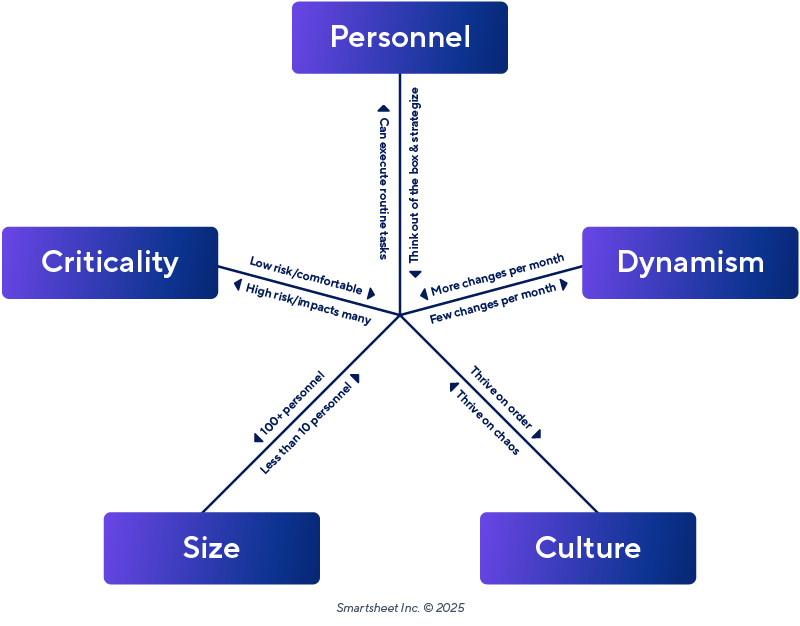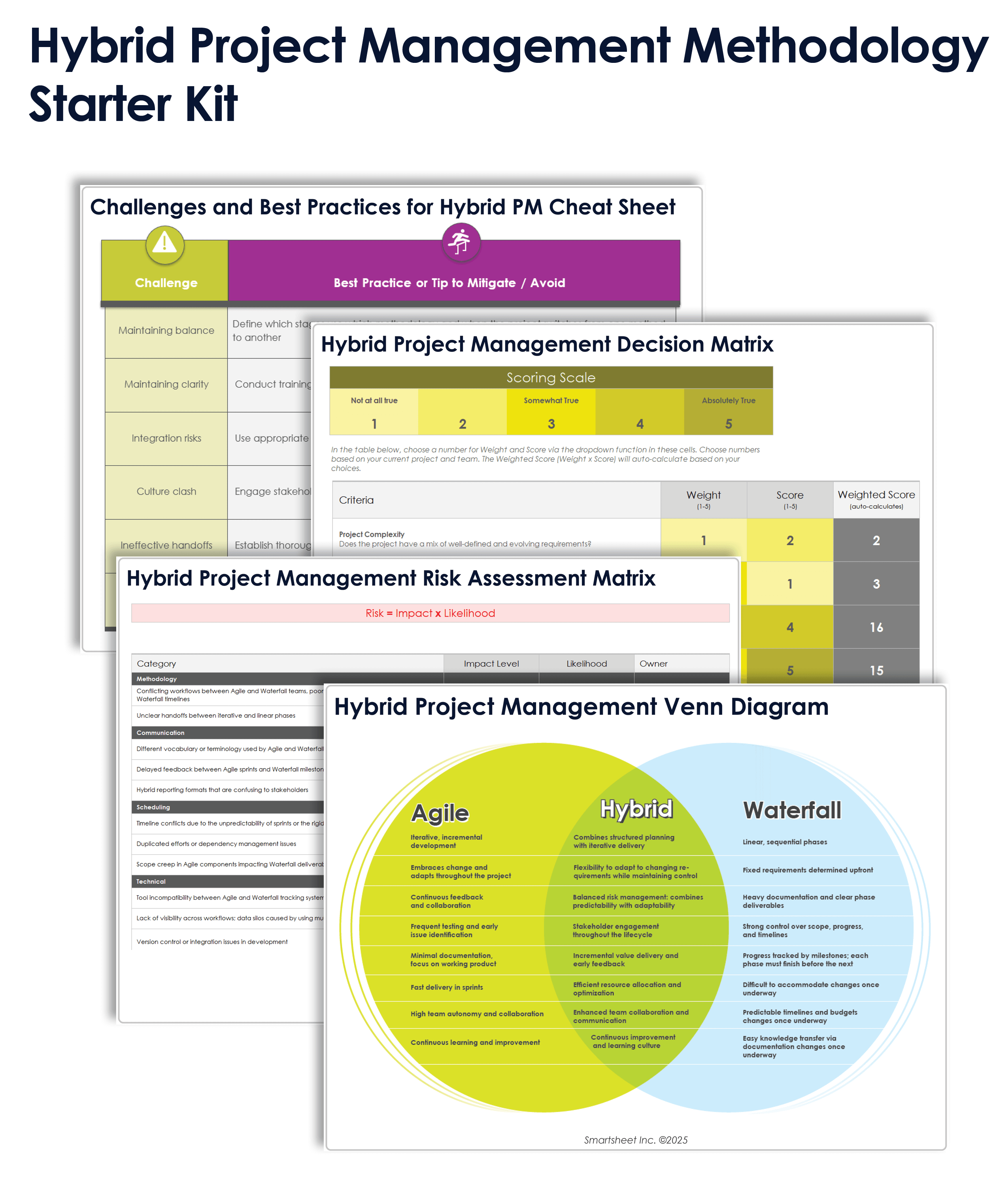What Is Hybrid Project Management?
Hybrid project management is a plan that combines predictive methods such as Waterfall with iterative methods such as Agile to create a custom method tailored to a project’s needs. It aims to leverage the strengths of each methodology while minimizing their drawbacks.
To learn more about strictly iterative methods, see these Agile project management resources. For more on predictive methods, see this article on Waterfall project management.
The Increased Adoption of Hybrid Project Management
Hybrid project management is on the rise as organizations face increasingly complex projects. By blending Agile flexibility with the structure of traditional methods, hybrid approaches help teams adapt quickly to diverse project needs. Recent survey data shows an increase in hybrid adoption, signaling a shift away from one-size-fits-all methodologies.
The Project Management Institute’s Annual Global Survey from 2024 found that between 2020 and 2023, the percentage of respondents using predictive project management methodologies decreased by about 24 percent, while the percentage who reported using hybrid methodologies increased by more than 57 percent. Between 2022 and 2023, hybrid project management was the only approach where usage increased. Usage of both Agile and predictive methods, on the other hand, decreased.

“The fundamentals for hybrid are simple: a multistep process while using Agile methodologies, or Agile methodologies with some multistep requirements,” says Erika Water, Project Manager at Insight Global. “Not all hybrid projects are the same.”
Hybrid frameworks are becoming more popular as a “fit for purpose” solution. They are especially effective for complex or rapidly changing project environments that require a careful combination of structured planning and flexibility. This includes large-scale projects in dynamic and innovative industries, such as software or pharmaceutical development. Project managers and teams are increasingly using tools such as Smartsheet, which provide the customizable balance of flexibility and structure necessary for implementing a hybrid methodology.
In Smartsheet’s 2025 Project and Portfolio Management Priorities Report, we found that change is now a constant in the workplace. About 97 percent of respondents reported experiencing change at work, most commonly caused by technological disruptions, organizational evolution, and industry or macroeconomic shifts; 70 percent of them reported a “significant” or “moderate” increase in how often they experienced change in 2024 compared to previous years.
However, we also found that these repeated efforts to implement one-size-fits-all, organization-wide Agile transformations has led to growing Agile transformation fatigue, as well as a revived enthusiasm for the stability of predictive methods. In other cases, complete Agile transformation isn’t even possible given the size or culture of an enterprise. Hybrid models are a practical, strategic combination of both approaches, allowing organizations and teams to settle on an approach customized to their project needs.
Hybrid project management methods foster greater openness to — and readiness for — change, allowing goals, scope, and expectations to shift and adapt in real time. Among the 1,400 project management professionals we surveyed, nearly half (42 percent) reported using hybrid methods in their organization, making hybrid project management the most popular approach. Additionally, 41 percent of those who used hybrid methodology said they “always” had visibility into the information they needed to anticipate disruption and make necessary decisions to pivot quickly.
Benefits of Hybrid Project Management
Hybrid project management blends elements of both traditional and Agile methodologies, enabling teams to customize their approach to a project’s unique needs. This flexibility offers several key benefits, including improved adaptability, higher productivity, and more effective risk management compared to using a single method alone.

“I think that teams themselves often feel more productive under a hybrid approach, as it balances the defined milestones and clear long-term goals typical of Waterfall with the empowering flexibility and adaptability of Agile,” observes Andrea Patrucco, who edits the Journal of Supply Chain Management and teaches in the Department of Marketing and Logistics at the Florida International University College of Business. “This dual aspect often motivates teams and enhances productivity because it sets clearer expectations and makes the workload more manageable.”
Here are several benefits of a hybrid project management methodology:
- Improved Clarity: Hybrid blends the structured communication systems of Waterfall project management with the consistent feedback loops of Agile — combining detailed long-term reports and milestone check-ins with daily stand-ups and collaborative tools. This can ensure that all stakeholders are on the same page about larger goals.
- Better Management of Complexity: As projects grow more complex across industries and organizations, they require more nuanced project management approaches. Hybrid project management allows teams to tailor their approach to the unique requirements of each phase or component, helping to manage complexity and reduce risk in dynamic environments.
- Greater Relevance to Market Demands: New technologies and fast-evolving customer expectations require organizations to increase personalization and reduce time to market. Hybrid approaches can help organizations meet these demands by improving their efficiency.
“Hybrid excels because iterative feedback loops are embedded within traditional project timelines,” says Patrucco. “Project stakeholders can continuously validate the product’s characteristics, features, and requirements to ensure they align with the planned scope, allowing timely adjustments to ensure the final outcome closely matches actual user needs.” - Enhanced Flexibility: Hybrid combines the structure of Waterfall with the adaptability of Agile, meaning teams have the systems in place to respond to change quickly while staying on track with high-level plans and timelines. It is also a practical transitional method for teams or organizations accustomed to predictive project management but looking to move toward more iterative methods.
Hybrid can also allow organizations resistant to Agile to make gradual or incremental changes to their project management systems, which helps mitigate the risk of team members or managers feeling overwhelmed by sudden change.
“A ‘liquid’ environment is one that is always changing,” says Water. “Most commonly this is when requirements change or are replaced, removed, or moved to a different phase. To implement a more ‘liquid’ environment, hold planning sessions — or retrospectives — to revisit each phase’s requirements in a sprint. This works best in a Waterfall/Scrum hybrid project.” - Stronger Risk Management: Hybrid project management can support proactive risk management by combining long-term forecasting with real-time responsiveness. Predictive methods allow teams to identify potential risks early, while the frequent reviews of Agile enable them to respond quickly and implement necessary changes to minimize impact.
- Increased Productivity: Teams using a hybrid approach can assign the right method — whether iterative or predictive — to the right stage of the project so that teams can pivot without losing momentum and waste less time on inefficient workflows. They can track high-level, long-term project goals using a more predictive system, and develop core features or meet short-term goals with Agile sprints. This iterative execution, nested within broader and more detailed planning, allows faster time to market while maintaining focus on long-term goals.
Learn about another Agile methodology that helps improve productivity in this guide to Lean project management. - Smarter Resource Allocation: Hybrid methodologies provide visibility into who is working on what across both long-term milestones and short-term sprints. This broader view can allow project leads to assign resources more soundly, enabling the correct allocation of personnel on the appropriate tasks at the right time and greater flexibility than traditional Waterfall planning.
- Stronger Stakeholder Alignment: Some stakeholders might lean toward slower communication — formal documentation, reports, and planned check-ins — while others might lean toward fast, continuous improvement through regular feedback and more frequent check-ins. Hybrid project management methods offer a comfortable middle ground for both.
Human-Centric Hybrid Project Management
A core benefit of hybrid project management is its ability to balance structure with a human-centric approach. Traditional methods often reduce individuals to resources and focus heavily on outputs, while Agile can sometimes leave teams without enough guidance. A hybrid approach values structure while recognizing that people are the true drivers of success.

Christina Sejr Pedersen is the Executive Director of the Half Double Institute, a project management nonprofit consultancy that uses the Half Double methodology, a hybrid approach to project management. She highlights the importance of a human-centric angle in the hybrid approach. “If you look across the world, sectors, phases, and types of projects, there’s one thing that all projects have in common: They consist of people,” she says. “I think the people management aspect is somewhat undervalued in the existing methods.”
Pedersen says that the Agile approach to project management sacrifices too many benefits of structure and clear guidance. “I think they threw the baby out with the bathwater,” she says of the Agile manifesto. “I think the major mistake they made, if I have to be really critical, is the self-leading teams. People actually want a leader — but they don’t want a bad leader.”
At the same time, she says, traditional project management approaches tend to “reduce people to resources.” Pedersen pushes back on that idea: “People are not resources — they are people,” she says. “And you don’t check your feelings at the door when you walk into the office in the morning. You come in as a whole person with dreams and anxieties … and you need a leader to be able to see that.”
A successful hybrid approach, according to Pedersen, is one that is more human-centric than traditional methods and more guided than Agile. “I think if you add this leadership element without reducing your participants to resources — as I think there’s a tendency to do in more traditional project management — you’ll get happier employees,” she advises. “They’re more motivated because they don’t want to be reduced to their deliverables — we all want to be part of something bigger.”
One way to operationalize that kind of leadership is rethinking traditional structures. “One of the things that we are really passionate about in the Half Double leadership model: We do not believe in steering committees,” Pedersen says. “We have the concept of a project owner — who is a very strong and engaged project owner, who needs to spend two to three hours a week on this project. And the project group does not go up to the owner. The owner comes down in the project room — and participates.”
A disengaged steering committee could be a huge problem for a project’s effectiveness and morale, Pedersen believes: “I’ve been in these steering committee meetings that feel more like a firing squad than a cheerleader. They don’t work.”
Challenges of Implementing a Hybrid Methodology
The transition from either Waterfall or Agile to a hybrid project management method can be challenging, from a technical and a personnel perspective. It can be hard to find a balance, and integration comes with risks and can cause confusion.
Implementing hybrid methodology requires thoughtful planning to ensure alignment with your business goals while keeping in mind your team’s capacity for change. Organizations can often resist unfamiliar methods, so it’s important to address concerns and provide training when transitioning to hybrid for the first time.

Because hybridization has no fixed formula, the real challenge lies in how project managers customize the method for the specific project requirements. “Hybrid does offer more opportunities for stakeholder management as it blends structure from Waterfall with the visibility and iterative feedback from Agile,” says Cornelius Greyling, a former senior project manager at Natuvion. “But this will only pay off if the methodology is competently executed.” As such, some of the challenges of hybrid methodology are also what makes it beneficial.
Here are some common challenges of hybrid project management — and some best practices to help mitigate them:
- Maintaining Balance: Merging the best of both predictive and iterative approaches is not easy. Project managers implementing hybrid methodologies might find it difficult to decide when to adapt to changing circumstances and when to stick to a plan. To avoid this, it might help to define which stages use which methodology and, when possible, plan transitions between methods in advance.
- Maintaining Clarity: Hybrid project management is generally more complex than either purely predictive or purely Agile methods. Not knowing which parts of the project follow which system can cause confusion, as can coordinating across multiple teams using different systems at different times. Team members might also be more resistant to a project that feels inconsistent — sometimes rigid, sometimes fast and flexible — leading to confusion and mismatched expectations. Team leads can mitigate some of this with thorough training on both hybrid methods and on new systems or processes that a particular project requires.
- Integration Risks: Integration comes with both Waterfall-side risks, such as misaligned scope or timeline, and Agile-side risks, such as scope creep. It can also create information silos or reduced visibility, especially when Agile iterations clash with Waterfall milestones or when tools aren’t compatible. One way to minimize communication breakdowns between Agile- and Waterfall-accustomed teams is to use integrated project management tools — such as Smartsheet — that improve visibility and control across teams. This includes using hybrid-friendly KPIs, reporting formats, dashboards, and a combination of both iterative reviews and milestone tracking.
- Culture Clash: Teams accustomed to working in Agile sprints might find the structure of Waterfall restrictive, while teams used to Waterfall milestones might find the flexibility of Agile chaotic. When developing a hybrid project management method for a specific project, it’s important to engage all team members and stakeholders early on and foster a culture of collaboration and shared vision.
- Change Management: Frequent handoffs between Agile and Waterfall processes in a hybrid system can cause delays or confusion. For example, a team might develop a prototype using an Agile process, but pass it on for testing without the paper trail required by the Waterfall team. It can help to have robust change management processes in place so that everyone involved knows the requirements and expectations at handoff points.
- Resource Allocation: Project managers using a hybrid method must balance resource allocation across both fixed Waterfall timelines and flexible Agile sprints. Because allocation decisions often depend on how teams are progressing toward their goals, they also need to track both project completion (a Waterfall metric) and sprint velocity (an Agile metric). A master schedule or roadmap that aligns sprints with Waterfall phases and dependencies can help them do this.
This cheat sheet will help you address the common challenges associated with hybrid project management:

Download the Challenges and Best Practices of Hybrid PM Cheat Sheet for Adobe PDF
When to Employ a Hybrid Approach
Employ a hybrid project management approach when a project would benefit from both Agile and Waterfall methods, and it wouldn’t succeed using only one. Deciding when — and to what degree — to use a hybrid model depends on factors such as project characteristics, team and stakeholder needs, resource availability, and organizational readiness.
In his article “Custom Methodology Merging — Tailoring Hybrid Project Management Methodologies,” Greyling emphasizes the importance of adapting hybrid methods to each project’s needs. “Because no one-size-fits-all hybrid approach can meet the unique needs of every customer or project, a critical first step is conducting a fit-for-purpose assessment,” he writes. “This involves evaluating the specific characteristics, constraints, and goals of the project in order to define or adapt a custom methodology … the resulting approach aligns with the unique chemistry of the project.”
At the same time, he adds, “this doesn’t mean it’s a free-for-all where every project is left to reinvent the wheel. A tailored methodology must be deliberately designed, aligned with all key stakeholders, clearly documented, and formally approved during the early project definition stages.”
To learn more about how to effectively get the benefits of both structure and flexibility, check out these five key tips for adopting hybrid project management from experts across industries.
Here are some factors to consider when selecting a hybrid approach to a project:
- Project Requirements: Complex projects with diverse requirements — such as those that involve both well-defined, sequential tasks and more iterative, evolving work — might be best suited to a hybrid method.
- Budget Flexibility: Merging different types of project management methodologies requires flexible budgeting across time, personnel, and financial resources. Because deliverables may evolve, project teams need the ability to reallocate resources midstream — adjusting timelines, shifting staff, or revising costs as needed. Regular oversight helps ensure these changes stay aligned with project goals and constraints.
- Market Requirements: New technologies and evolving customer expectations are forcing companies to be more competitive, whether by making products more personalized or reducing time to market. In such instances, teams and organizations accustomed to Waterfall would benefit from a hybrid approach.
- Team and Stakeholder Readiness: Team members need training and preparation to work effectively in a hybrid environment, especially with elements they might not have used in more clearly defined Agile or Waterfall projects — such as dual-layered reporting or integration tools. A hybrid approach demands strong communication and a collaborative spirit. Clients and stakeholders, in turn, must be ready and willing to support the flexibility — and occasional unpredictability — of a hybrid approach.
- Continuous Evaluation: A hybrid approach requires teams to regularly gather feedback and implement adjustments and improvements — perhaps even more so than in a purely Agile project, due to the increased risk of misalignment and added complexity of dual workflows.
The Project Management Institute has selected five key lines of assessment when considering what kind of management method a project needs: size, criticality, dynamism, personnel, and culture. Evaluating each of these five factors can help teams determine whether and how to create a hybrid model based on how much Agile or predictive structure the project requires.

Here’s a closer look at PMI’s five key factors to help guide your decision:
- Size: Agile favors smaller teams and products, while more predictive models favor larger teams and products.
- Criticality: Agile methods should be used when both the stakes of failure and risks to the public are low, while predictive methods are better for higher-criticality projects. For example, Agile is suitable in creative industries such as software, marketing, or product design, while predictive methods work for more regulated industries such as pharmaceuticals, defense, or auto manufacturing.
- Dynamism: A project that begins with detailed designs and will likely have minimal change requirements later is better suited to a Waterfall method, while projects that involve minimal design at the beginning followed by constant refactoring are better suited to Agile.
- Personnel: Agile projects work best with team members who are creative problem solvers and can think outside the box. Waterfall projects, on the other hand, might benefit from strong managerial input during the design stage, and can succeed later stages with team members who thrive in structured, rule-based environments.
- Culture: Agile projects are more successful in an organizational culture that value freedom and creativity, while Waterfall projects are better suited to cultures that prefer stability and clearly defined rules
| Hybrid PM is ideal when... | |
|---|---|
| Size | The team is not too big or too small, and it includes members who are familiar with Agile techniques as well as those experienced in traditional methods. |
| Criticality | The project poses medium risk and requires both structured governance and creativity. |
| Dynamism | The project is too large and complex for Agile and too dynamic for Waterfall, and it involves multiple departments or vendors. |
| Personnel | The organization is transitioning from traditional to Agile, or the team includes both creative and managerial minds. |
| Culture | There is a healthy balance of team members who thrive in either flexible or structured environments. |
Here are some other questions that can help you think through whether your project requires a hybrid methodology:
- Flexibility Needs: How much flexibility, real-time feedback, and adjustment will be required for this project?
- Process Structure: Does the project involve clear steps and processes in a fixed order with specific requirements?
- Team Adaptability: How comfortable is your team with transitions?
- Experience and Training: Does the team have experience with Agile, Waterfall, or both? What training would your team require if working on a project using both Agile and Waterfall methods?
- Culture Fit: How supportive is the organizational culture with experimental processes?
- Collaboration Ability: Can the team collaborate effectively for a successful implementation?
- Tool and Resource Readiness: Are the necessary tools, templates, and resources available to support a hybrid methodology?
- Stakeholder Involvement: How much involvement will external stakeholders or clients have during the project lifecycle?
- Compliance Needs: What regulatory, documentation, or compliance requirements does this project involve?
- Project Priorities: Which of these is most important for the project: speed, flexibility, predictability, compliance, or innovation?
- Team Availability: How available will the project team be to touch base daily or weekly for the duration of the project? Will the team be dedicated to this project or will they have other projects on their plate?
- Budget Flexibility: How flexible is the budget?
- Feedback Channels: What feedback channels do we have in place?
Patrucco has seen successful hybrid project management in cases where traditional methods were used at the beginning of a project, while more Agile methods were used later. “I once saw a case of a retailer that effectively applied a hybrid approach when upgrading its procurement software,” he says. “The initial phases of software development — planning, requirements documentation, and vendor selection — were conducted following the typical Waterfall approach to maintain control and predictability. Once the team began implementation, they shifted to Agile sprints for development and rollout.”
This was helpful, Patrucco explains, “because they frequently adapted to evolving supplier needs and internal feedback … the final platform, integrated with the suppliers, was easily adaptable to market — and inventory — dynamics and supplier preferences.”
If you decide against a hybrid approach, this article on Agile vs. Waterfall vs. Scrum can help you pick the right methodology for your next project.
How to Set Up a Hybrid Project
To set up a hybrid project, start by assessing your project requirements and defining clear phases for both traditional and flexible aspects of the project. Choose the right training and tools, assign roles accordingly, and establish a communication system that works for everyone. Review your progress and adjust as required.
Here is a step-by-step guide to setting up a hybrid approach to project management for your project:
- Assess Project Requirements
Start by evaluating the project’s scope, complexity, timeline, external environment, and stakeholder expectations. Determine which parts of the project need structured planning and which require flexibility and allow time for iterative development. For example, a predictive approach may be better suited to high-level design, while an Agile or iterative method may be better suited to development.
Next, assess your current management practices in relation to your project requirements. This can help you identify strengths and weaknesses and ensure that your hybrid approach supports your team’s capabilities.
Pedersen shares some best practices that the Half Double Institute recommends: “The first thing, do an impact case. You do this with visual planning — define the project group and allocate responsibilities. For example, we say nobody should work on more than two projects at a time.”
- Define Project Phases
Establish a timeline of major project phases with clear objectives. Within each phase, determine where planning is essential and where sprints or more iterative change can support continuous assessment and adjustment. “Defining the boundaries between the two methods is essential before launching the project,” says Patrucco. “Which aspects of your project are suited to Waterfall — such as regulatory compliance or fixed milestones? Which aspects can benefit from Agile flexibility, such as product development phases?”
- Provide the Right Training and Tools
Ensure everyone understands how the hybrid approach works and how their roles may differ from other projects they’ve worked on. Provide targeted training in both Agile and traditional project management practices, including how and when each will be used in the project.
In addition, select hybrid project management tools and software — platforms that support both Agile-style tracking and Waterfall-style documentation — and ensure they’re a good fit for both the team and the project. These tools should support collaboration, visibility, regular communication, and smooth integration between the two methods.
“Hybrid is indeed complex — even more complex than Agile-only — and there is the need for targeted training sessions to ensure your project team understands both methodologies, specifically how they interact in a hybrid environment,” advises Patrucco. She recommends project simulation exercises or design thinking workshops, which are sessions where teams can define challenges and align on how to apply hybrid methods.
- Customize Your Approach
Every implementation of hybrid project management will be different. Develop a tailored framework specific to your project, combining elements of each methodology based on what’s needed — and where.
According to the Half Double methodology, hybrid project management should be customized to the specific needs of each project, phase, and division. Different projects have different requirements, but so too do different phases within a project, as well as different divisions within an organization.
“If you have high uncertainty and you’re in the early phase of the project, you should probably emphasize the more Agile methodologies and less detailed planning. If you have a project with low uncertainty … then I would probably do more detailed planning,” says Pedersen. A project with high uncertainty might involve the development of a new, untested app, while one with low uncertainty might be constructing a standard building using established plans. “You look at your project and you figure out what is the right blend of Agile and prescriptive depending on the uncertainties and characteristics of the project, and no answer is going to be exactly the same.”
- Set Key Milestones
Setting key milestones provides structure and clarity — especially in a hybrid model, where iterative work happens alongside fixed timelines. These milestones help anchor the project by tracking progress in Waterfall phases while still allowing Agile teams the flexibility to iterate within each milestone period. In addition to aligning short-term iterations with long-term goals, milestones also support collaboration between Agile and Waterfall teams and improve visibility and reporting for stakeholders.
- Manage Assumptions
Continuously identify and document any assumptions about resources, roles, responsibilities, dependencies, and timelines. Teams should review these assumptions and validate them during check-ins or reviews to ensure they still hold true — or to update them as required. Make sure to communicate updates to the team, especially when work on one side of the project affects the assumptions of another — for example, when Agile iterations uncover risks that could impact Waterfall components.
Pedersen recommends the “pulse check” to catch misalignment early. “Once a week, or once every two weeks, you actually ask your stakeholders or your clients — even though it can be uncomfortable — ‘Do you still believe in this project? Are we on the right track?’” she says. “So many project managers forget to ask their stakeholders, or they don’t want to because it’s uncomfortable. But it’s better to ask early than when it’s too late.”
- Develop a Communication Plan
Create a communication plan that encourages empathy, transparency, and collaboration. Define how, when, and where teams will communicate across both Agile and Waterfall workflows, and specify channels for daily updates, formal midterm reporting, and milestone reviews. Ensure all stakeholders know how often they should check in or report at each stage of the project.
“At the operational level, clearly define communication channels, meeting frequency, and responsibilities,” advises Patrucco. “Agile-style daily stand-ups and periodic Waterfall milestone reviews are important for progress monitoring.”
- Establish a Reporting Mechanism
“Monitoring practices are important in every project, but especially in a hybrid environment,” Patrucco says. Establish a reporting mechanism that integrates both Agile and Waterfall data using a hybrid project dashboard. Use traditional metrics to track budget, schedule, milestones, and more, and use Agile metrics to monitor sprints and quality. Adjust plans and strategies as needed to ensure the hybrid approach remains effective and responsive.
Hybrid Project Management Starter Kit
Use this free starter kit to help you implement hybrid project management. It includes info sheets and templates.

Download hybrid project management starter kit
In this kit, you’ll find:
- A hybrid project management decision matrix for Excel to help you decide whether a hybrid approach is right for your project
- A hybrid project management risk assessment matrix for Excel to track the likelihood and impact of different risks
- A hybrid project management Venn diagram info sheet for Adobe PDF to help you understand the relationship between Agile, Waterfall, and hybrid
Hybrid Methodology Case Study
In this hybrid project management case study, project leader Cornelius Greyling spearheaded a successful SAP S/4HANA implementation at a Chilean bank. With a fixed scope, timeline, and budget, he combined structured planning with sprint-based delivery to improve communication, flexibility, and system stability while meeting strict project constraints.
Greyling shared his experience on this project, which was the first SAP implementation of S/4HANA in a Chilean financial institution. Greyling managed the migration over to SAP S/4HANA and SAP Ariba, which together would enable a complete source-to-pay process for the institution.
The project was tightly constrained by the Iron Triangle of project management: scope, cost, and time. “The timeline was fixed,” says Greyling. “The system had to go live before the end of the year so the bank could close the fiscal year in the old system and begin the new year in the new one.” Additionally, the scope was defined in detail based on a catalog of requirements from the proposal. “This requirements baseline was handed over to the project as a mandatory scope definition,” Greyling says. Finally, he says, “this was a fixed price project, which meant that getting any change requests signed against the scope, schedule, or cost was highly improbable.”
The bank used SAP Activate, which is SAP’s official implementation framework for deploying SAP solutions such as S/4HANA. “It’s a hybrid project management methodology by design,” says Greyling. “SAP Activate is a glove-fit for SAP implementations. It’s not always straightforward … one needs to be focused on applying only those elements that are a fit for the individual project.”
In this case, SAP Activate allowed for a combination of Waterfall and Agile elements by using structured planning up front and iterative development later in the process.
During the Explore phase of the Activate method — which is similar to the Requirements Gathering and Analysis phase of the Waterfall method — “SAP Fit-to-Standard workshops were conducted to verify how the RFP requirements would be covered by the SAP standard,” Greyling says. “When delta requirements were identified, they were added to the product backlog, along with all configuration or customization needed.”
This enabled the teams to set the project up for Agile elements later. “Creating the backlog in a format useful for sprint planning and the finalization of the detailed project plan was a challenge,” Greyling says, “but it very much paid off during the sprint realization phase.”
Once the backlog was complete and planning finalized, the team shifted into a modified Scrum approach tailored for SAP, enabling incremental implementation. Greyling says this was hugely valuable.
Here are some benefits of a hybrid approach Greyling noticed:
- Flexibility and Real-Time Adjustments: “Business representatives were on the Scrum teams and could validate the configurations and functionality as they were built,” Greyling says. The flexibility of sprints also allowed for content adjustment during implementation, before the beginning of the next sprint. “This meant that sometimes elements of the sprint backlog were moved to another sprint or marked as canceled in the product backlog.”
- Improved Communication: The cross-functional teams grew more collaborative with each sprint, understanding not just the project and configurations but also each other. Greyling says this “generated a tangible sentiment of shared ownership, which would not be common to encounter in a traditional Waterfall project.”
- High Confidence: With consistent and accurate reporting after every sprint, teams and managers gained confidence in the solution at each step. “Reaching this level of visibility would have been far more laborious using pure Waterfall, which often lacks meaningful system maturity indicators,” Greyling observes.
Another element of the hybrid method that Greyling’s project used were stabilization sprints, a common element in SAP Activate. ”Time-boxing the sprints carries the risk of not completing all the planned backlog items,” Greyling says. As such, the team used stabilization sprints to address its technical backlog.
“These sprints were focused on tackling the remaining technical debt and, as the name suggests, improving the quality and stability of the implementation,” he says. Stabilization sprints are less about adding new features and more about making a system more reliable — in this way, they are similar to the phases reserved for testing and fixing at the end of a project using the Waterfall methodology.
“The management of technical debt requires proactive planning and implementation of strategies to continuously track and maintain risk level,” Greyling says. “Teams can avoid technical debt accumulation by monitoring progress and regularly refining their backlog.”
Design the Perfect Hybrid Agile-Waterfall Methodology With Smartsheet for Project Management
From simple task management and project planning to complex resource and portfolio management, Smartsheet helps you improve collaboration and increase work velocity -- empowering you to get more done.
The Smartsheet platform makes it easy to plan, capture, manage, and report on work from anywhere, helping your team be more effective and get more done. Report on key metrics and get real-time visibility into work as it happens with roll-up reports, dashboards, and automated workflows built to keep your team connected and informed.
When teams have clarity into the work getting done, there’s no telling how much more they can accomplish in the same amount of time. Try Smartsheet for free, today.